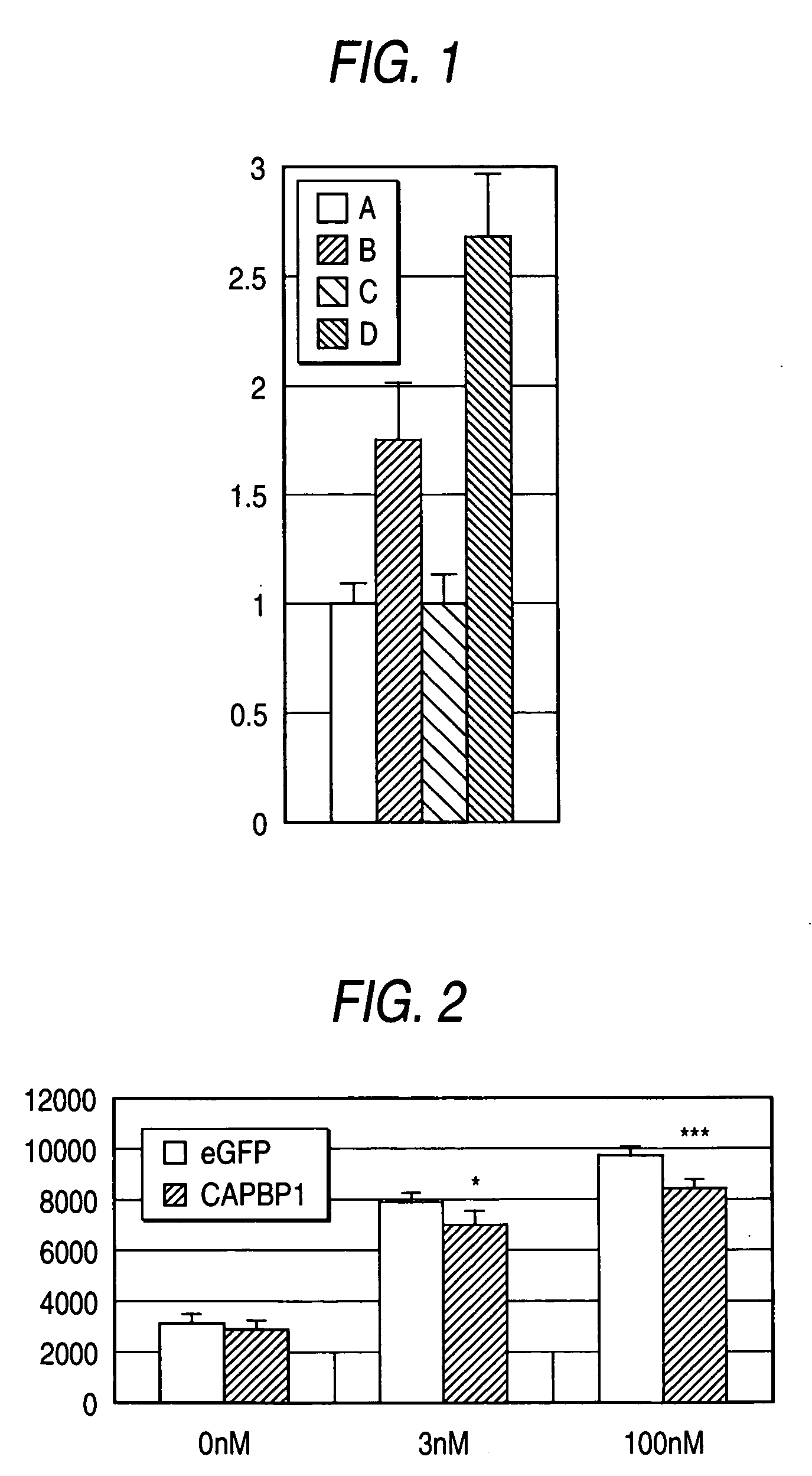Cap-binding protein
a technology of cap-binding protein and cap-binding compound, which is applied in the field of new polypeptides, can solve the problems of undiscovered experimental support of use, and achieve the effects of improving insulin resistance, cap-binding activity, and improving insulin resistan
- Summary
- Abstract
- Description
- Claims
- Application Information
AI Technical Summary
Benefits of technology
Problems solved by technology
Method used
Image
Examples
example 1
Cloning of CAPBP1 Gene and Construction of the Expression Vector
(1) Cloning of CAP
[0089] With reference to a cDNA sequence encoding a full length region of mouse CAP (c-Cbl associated protein) described as Accession No. U58883 of gene database, GenBank, the following four oligo nucleotides named mCAP-5HS, mCAP-1, mCAP-2 and mCAP-3SE were designed as primers (SEQ ID NOs:5 to 8). To mCAP-5HS, a restriction enzyme HindIII site is added, and to mCAP-3SE, a restriction enzyme EcoRI site is added on the 5′ side of each primer.
[0090] Total RNA was prepared from the skeletal muscle of male 15-weeks old C57BL / 6J mice (CLEA Japan, Inc.), and single strand cDNA was produced by reverse transcription to use as a template of PCR for CAP gene cloning. The total RNA was prepared using a reagent for extracting RNA (Isogen: NIPPON GENE CO., LTD.) according to the instruction manual. Thus prepared total RNA was then treated with deoxyribonuclease (NIPPON GENE CO., LTD.), followed by phenol / chlorof...
example 2
Production of Culture Cells Expressing CAPBP1 Protein
(1) Production of CAPBP1 Expressing Cell
[0102] The expression plasmid pcDNA-CAPBP1 (−) and pcDNA-CAPBP1 (+3) produced in the above Example 1 (5) were introduced into COS-1 cells, respectively. The COS-1 cells were cultured to be in a 70% confluent state by adding 2 ml of a minimum essential medium DMEM (GIBCO) supplemented with 10% fetal bovine serum (Sigma) to each well on the culture dish of a 6-well culture plate (well diameter of 35 mm). The cells were transiently transfected with pcDNA-CAPBP1 (−) or pcDNA-CAPBP1 (+3) (1.0 μg / well) by a calcium phosphate method (Graham et al., Virology, 52, 456, 1973; Naoko Arai, Gene introduction and expression / Analytical method (Kaiseki hou) pp. 13-15, 1994). After culturing for 48 hours, the medium was removed, and the cells were washed with a phosphate buffer (hereinafter, abbreviated as PBS). Thereafter, the cells were lysed by adding 0.1 ml of a cell lysis solution (100 mM potassium p...
example 3
Analysis of Tissue-Dependent Distribution of Expression of CAPBP1 Gene
[0104] Since the CAPBP1 protein interacts with CAP, it was expected that the protein is expressed in insulin responsive tissues, whereby acting on the insulin signal in the second pathway. Thus, presence or absence of the expression of CAPBP1 in various type of tissues was examined by a PCR reaction from cDNAs derived from the various type of tissues to amplify the full length cDNA fragment of the CAPBP1 gene represented by SEQ ID NO:1 or 3 using a pair of primers which are homologous to CAPBP1 represented by SEQ ID NO:12 and SEQ ID NO:14 as described above. Using DNA polymerase (AmpliTaq(R) DNA polymerase; Applied Biosystems, Inc.) with each in an amount of 1 μg of cDNA libraries derived from human bone marrow, brain, cartilage, heart, kidney, leukocyte, liver, lung, lymphocyte, mammary gland, ovary, pancreas, placenta, prostate gland, skeletal muscle and HeLa cell (Clontech) as a template, PCR cycle of at 98° C...
PUM
| Property | Measurement | Unit |
|---|---|---|
| Fraction | aaaaa | aaaaa |
| Electrical resistance | aaaaa | aaaaa |
Abstract
Description
Claims
Application Information
 Login to View More
Login to View More - R&D
- Intellectual Property
- Life Sciences
- Materials
- Tech Scout
- Unparalleled Data Quality
- Higher Quality Content
- 60% Fewer Hallucinations
Browse by: Latest US Patents, China's latest patents, Technical Efficacy Thesaurus, Application Domain, Technology Topic, Popular Technical Reports.
© 2025 PatSnap. All rights reserved.Legal|Privacy policy|Modern Slavery Act Transparency Statement|Sitemap|About US| Contact US: help@patsnap.com

